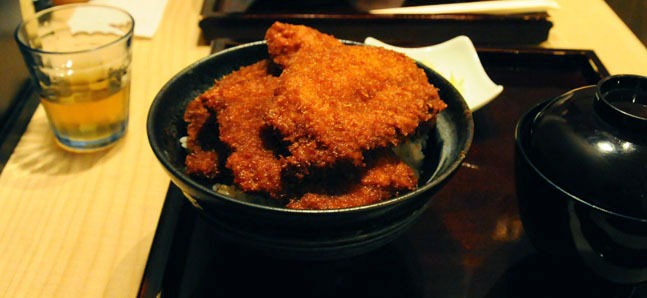
'Tare-katsudon' Tare-Katsu, Kichijoji
Posted: Thu Aug 05 2010
If asked to picture katsudon, most people would think of the customary bowl of rice topped with a crispy-coated, deep-fried pork cutlet and a lightly beaten egg. In reality, there are so many varieties of katsudon that they can’t really be summed up with one particular definition. In different regions of Japan, the dish could be seasoned in any number of ways, using sauces made from the reddish coloured akamiso fermented soy paste, soy sauce or even demi-glace – making any particular person’s image of the katsudon will be different, depending on where they are from. Time Out Tokyo picked the top five spots where you can get a genuine taste of the katsudon from five different areas, all within the reaches of Tokyo.
Okayama demi-katsudon: Koen-dori no Yoshoku-ya Roman

Roman also serves demi-katsudon – a particular specialty of Okayama City – where the katsudon is served covered with demi-glace sauce. As you’d expect from a restaurant specializing in yoshoku, the dish’s distinctive flavour comes from Roman’s demi-glace, with its delicious buttery aroma. The demi-katsudon is only available at lunch time (until 2pm), and will set you back ¥900, including coffee or tea.
(Full details & map)
Niigata tare-katsudon: Tare-Katsu, Kichijoji
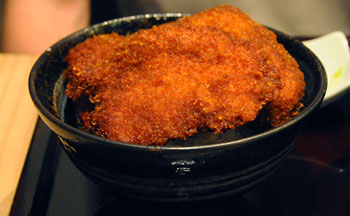
Niigata’s local katsudon is the tare-katsu. To make it, a thin pork cutlet, which has been dipped in a soy-based, salty-sweet sauce (tare), is placed on top of the rice. It’s said that this style of katsudon began in the early Showa Period, when street stalls started to sell shoyu-dare (soy-based dipping sauce) katsudon. At Tare-Katsu, ¥800 gets you a bowl of rice is completely covered with a generous serving of pork cutlets that can be eaten with condiments like wagarashi (Japanese mustard) and spicy habanero chili peppers.
(Full details & map)
Nagoya miso-katsudon: Yabaton, Tokyo Ginza
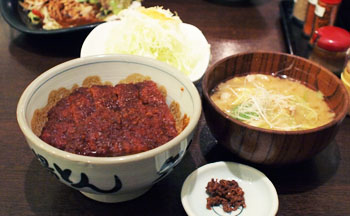
Miso-katsudon, with a pork cutlet dipped in a miso-based sauce, is popular in Nagoya and throughout the Tokai area. The standard style uses akamiso red fermented bean paste as its base, and is said to have its origins in the way people used to dip kushi-katsu (small pieces of crumbed, deep-fired pork on skewers) in dote-nabe (miso hot-pot) before eating them. Yabaton is a long established miso-katsu shop, first opening in 1947. Because they use carefully selected, high quality fresh meat, the pork doesn’t need to be tenderized before cooking and the miso-based sauce used to season the pork cutlet is made to Yabaton’s own secret recipe.
(Full details & map)
Fukui’s sauce-katsudon: Hokurikuo, Shinagawa
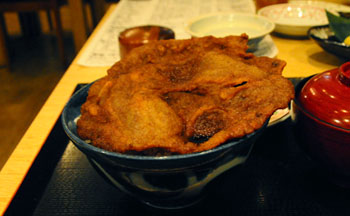
Fukui prefecture’s signature katsudon is the sauce-katsudon, where the deep-fried pork cutlet has been dipped in a special sauce before placing it on top of the rice. Another characteristic of the sauce-katsudon is the finely ground breadcrumbs used to coat the pork. Yoshoku restaurant Europe-ken in Fukui is said to have the birthplace of the dish. At Hokurikuo, sauce-katsudon is offered at lunchtime. The pork cutlet is quite large, so you might find it easier to eat if you put it on the lid of the bowl the katsudon is served in. In the evening, if you order both the rice and the sauce-katsu (the pork cutlet dipped in sauce), they will arrange it into a katsudon for you.
(Full details & map)
Tokyo tamagotoji-katsudon: Sanchoan
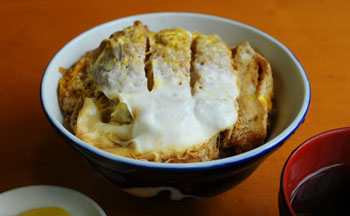
Sanchoan is a soba restaurant that dates back to the Edo Period and is located close to Waseda University, at the Babashitacho intersection. Sanchoan is said to have created curry nanban, but there is one other dish that it is also said to have brought into the world: katsudon, or rather, the style of katsudon that became popular in the Tokyo area - served with a beaten egg, which is poured over the pork cutlet and partially cooked. The interior is spacious and the walls are covered with shikishi cards signed by all the well-known people who have eaten there. There is always a member of staff right by the door so you can order and pay when you enter, and receive a ticket for your food. The taste is exactly what you would hope for from a soba shop katsudon. Sanchoan is definitely worth a visit.
(Full details & map)
Tweets
- About Us |
- Work for Time Out |
- Send us info |
- Advertising |
- Mobile edition |
- Terms & Conditions |
- Privacy policy |
- Contact Us
Copyright © 2014 Time Out Tokyo











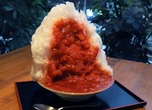

Add your comment